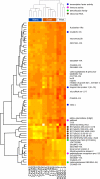Changes in transcript abundance relating to colony collapse disorder in honey bees (Apis mellifera)
- PMID: 19706391
- PMCID: PMC2736458
- DOI: 10.1073/pnas.0906970106
Changes in transcript abundance relating to colony collapse disorder in honey bees (Apis mellifera)
Abstract
Colony collapse disorder (CCD) is a mysterious disappearance of honey bees that has beset beekeepers in the United States since late 2006. Pathogens and other environmental stresses, including pesticides, have been linked to CCD, but a causal relationship has not yet been demonstrated. Because the gut acts as a primary interface between the honey bee and its environment as a site of entry for pathogens and toxins, we used whole-genome microarrays to compare gene expression between guts of bees from CCD colonies originating on both the east and west coasts of the United States and guts of bees from healthy colonies sampled before the emergence of CCD. Considerable variation in gene expression was associated with the geographical origin of bees, but a consensus list of 65 transcripts was identified as potential markers for CCD status. Overall, elevated expression of pesticide response genes was not observed. Genes involved in immune response showed no clear trend in expression pattern despite the increased prevalence of viruses and other pathogens in CCD colonies. Microarray analysis revealed unusual ribosomal RNA fragments that were conspicuously more abundant in the guts of CCD bees. The presence of these fragments may be a possible consequence of picorna-like viral infection, including deformed wing virus and Israeli acute paralysis virus, and may be related to arrested translation. Ribosomal fragment abundance and presence of multiple viruses may prove to be useful diagnostic markers for colonies afflicted with CCD.
Conflict of interest statement
The authors declare no conflict of interest.
Figures



References
-
- National Academy of Sciences. Status of Pollinators in North America. Washington, DC: National Academies Press; 2007.
-
- vanEngelsdorp D, Underwood R, Caron D, Hayes J. An estimate of managed colony losses in the winter of 2006–2007: A report commissioned by the apiary inspectors of America. Am Bee J. 2007;147:599–603.
-
- Cox-Foster DL, et al. A metagenomic survey of microbes in honey bee colony collapse disorder. Science. 2007;318:283–287. - PubMed
Publication types
MeSH terms
LinkOut - more resources
Full Text Sources
Other Literature Sources

